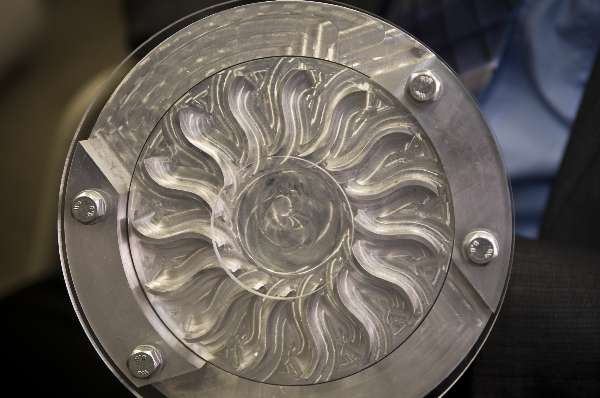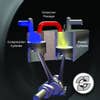The internal combustion engine gets a bad rap these days. With electric vehicle technology finally coming to market in meaningful ways, oil prices spiking, global warming looming, and “green” sentiments pervading American culture, motors driven by exploding carbon chains have become something of a pariah. But the truth is that we’re stuck with the internal combustion engine, and the petroleum-derived fuels that power it, for the next couple of decades, at least. But that doesn’t mean we can’t still trim fuel consumption and reduce emissions across the board. Designers large and small are building wholly new engines and components that slash fuel requirements, waste less heat energy, and squeeze the most out of every BTU, every engine stroke, and every iota of chemical energy that physics will allow.
Indeed, the internal combustion engine is far from dead. In automotive design shops and university labs across the world the gasoline engine is experiencing something of a technological renaissance.
Click to launch the photo gallery
The green thinkers among us need not fear this resurgence of hydrocarbon-burning engines; these innovations aren’t just drastically driving down the amount of carbon-based fuel our automobiles might someday burn in a given trip–they are crucial bridge technologies that will help get us to that all-electric, carbon free future as cleanly and efficiently as possible.
Most of these are still in the concept stage, awaiting funding or for their prototypes to demonstrate that they are up to the job. None of them is a silver bullet, but each serves as an example of how internal combustion technology could extract far more from the increasingly costly hydrocarbon chains that they burn, drastically improving efficiency and trimming waste without sacrificing too much of the performance that we’ve come to demand from our automobiles.
In the last century, gasoline engines became ubiquitous. In this century, they will become smart. Click through to the gallery see seven ways it’s already happening.
The Scuderi Engine
The Scuderi Group’s take on the split-cycle engine–one that splits the usual four stroke piston cycle between two different pistons–has a clever means of exploiting every bit of energy it can gather: a compressed air tank that captures energy that would otherwise be wasted. The split cycle engine works by splitting four-stroke duties between two complementary pistons connected by a passage. The first piston draws in air on the downstroke and then compresses it (and incoming fuel) on the upstroke. Unlike a conventional engine, the upstroke then forces the fuel-air mixture through a passage into a second cylinder where the ignition and exhaust strokes occur. This splitting of chores allows designers to tune the engine more precisely (particularly on the ignition stroke), extracting better efficiency from it. The Scuderi engine goes a step further by siphoning off unused compressed air that isn’t needed for the combustion stroke at low loads and storing it in a compressed air tank. Once the tank is full, that air can then be fed directly into the combustion cylinder, allowing the compression piston to stop working for a while. Compared to conventional engines, that’s like getting two of four engine strokes for free. So it’s no surprise that computer models show Scuderi’s design improving fuel economy over its conventional counterparts by 50 percent.
Tour Engine’s Hot-and-Cold Split-Cycle Design
Like the Scuderi Engine, this re-imagined internal combustion rig by San Diego-based Tour Engine is a split-cycle design. But rather than capitalizing on wasted compressed air, the Tour engine manages temperatures in different parts of the engine to help the engine run optimally. The problem: In a four-stroke engine, the first two strokes (intake and compression) take place most efficiently in a cold environment, while the second two (ignition and exhaust) work better in a hot environment. When all of that takes place in the same cylinder, engineers strike a compromise between the needs of each and the engine wastes a lot of energy (up to 40 percent) simply pulling heat away from the cylinders via the radiator. The Tour engine, being a split cycle, can keep the intake/compression cylinder cold, then pump the compressed fuel-air mixture into a hot combustion cylinder, ensuring that both halves off the cycle occur under more optimal conditions. Further, since compression is optimized by a small cylinder and combustion happens more efficiently when there’s more space for the explosion to spread out (more energy is lost to exhaust here in a conventional design), each side of the engine can be sized to best suit its particular task. Less energy lost to waste heat and exhaust translates into an immediate uptick in efficiency by about 20 percent, Tour Engine claims. With further improvements in design, engineers there think they could boost economy by more like 50 percent.
The Pinnacle Engine
Monty Cleeves, founder of Pinnacle Engines, wasn’t satisfied with the waste heat generated by conventional engine cycles, so he invented his own. Sort of. The Pinnacle engine is an opposed piston engine–a setup that is quite en vogue among engine designers right now–that dispenses with heavy cylinder heads that backstop the controlled fuel explosions. Instead, the design opts to place the explosion between two opposing pistons that are pushed apart in opposite directions (visualization here). No heavy cylinder heads means engines are far lighter, and greater power density means less energy is lost as heat. Then there’s the patented Cleeves cylce, that essentially allows the engine to switch between Otto cycle combustion (conventional gasoline engine, constant volume combustion) and Diesel cycle combustion (constant pressure combustion) depending on what’s more efficient for the job at hand. Pinnacle engineers are working to tweak other aspects–turbocharging, direct injection, valve timing–to squeeze even more out of the design. Throw in the fact that it exhibits efficiency gains across a range of fuels–gasoline, compressed natural gas, ethanol–and the Pinnacle engine shows promise. A small, scooter-sized engine will hit Asian markets in 2013, barring setbacks. But a larger automobile engine could be ready by 2016, with an estimated improvement over current conventional engines of–you may have guessed–up to 50 percent.
EcoMotors OPOC
OPOC stands for “opposed-piston opposed-cylinder,” and radical though it may be it has an impressive group of proponents that include a chief designer at Volkswagen (who designed it), a former top executive at GM, and renowned Silicon Valley investor Vinod Khosla. Like the Pinnacle engine, the cylinders are arranged opposite each other horizontally, but there’s a key difference: the OPOC has two pistons in each cylinder, and runs on a two-stroke rather than a four-stroke cycle. Each cylinder conducts its combustion right in the center, and pistons on either side of that explosion are propelled in opposite directions. Long connecting rods connect the outermost pistons back to the crankshaft in the middle of the engine block. Like other opposed piston designs, the OPOC needs no heavy cylinder heads, reducing weight. And because the pistons only have to travel half as far as in a traditional gasoline engine, the engine can run faster. Turbochargers (powered by very small electric engines when at low rpm when exhaust energy is low) keep pressure in the cylinders during the exhaust/intake stroke, clearing the fouled air and bringing fresh air in. And, if engineers at Ecomotors can make it work the way they think they can, the savings could be huge. The company hopes to demo the OPOC in a 100-mpg passenger car at some point in the near future.
Riding on Shockwaves
Pistons, valves, and camshafts have propelled gasoline engines for a century, but in the coming century they could become scarce. Michigan State researchers are developing a new kind of electricity-producing gasoline engine that generates shockwaves to sustain engine motion. The concept is anchored around a rotor containing several radial channels. As it spins, a fuel-air mixture enters through a series of ports at its center, filling the chamber in which the rotor resides. The rotors timing is such that at certain points during it’s rotation any fluid inside the chamber could escape through holes in the side of the chamber, but during this compression stroke the rotor is turned such that the exit ports are blocked. As the mixture surges in, the pressure in the chamber spikes suddenly, generating a shockwave that travels inward, compressing the fuel air mixture in the center further. Then: ignition. By this point–this concept is all about timing, you see–the rotor has turned just enough that the exhaust ports in the chamber wall are now exposed and the hot exhaust can escape. As it does so, it pushes those radial channels and turns the rotor, supplying power and resetting the rotor for the next cycle. And so on. It’s a pretty radical re-imagining of the internal combustion engine, but one that comes with noteworthy benefits. A “wave disc” engine like the one described could turn 60 percent of the fuel consumed into actual propulsion, a vast improvement over the 15 percent conversion efficiency of conventional engines (that’s right: your current ride likely wastes 85 percent of your gasoline’s chemical energy). It would also replace nearly 1,000 pounds of engine weight, contributing to those savings and reducing the number of moving parts that wear out over time.
Replace the Aging Spark Plug with Lasers
Lasers make everything better, and internal combustion engines are no exception. The spark plugs driving combustion in conventional gasoline motors do their jobs effectively enough, but not as efficiently as they could. In order to achieve ignition the fuel-air mix has to contain a certain minimum amount of gasoline. A hotter spark would ignite a mix with more air and less fuel, but hotter sparks also degrade the electrodes more quickly. Once again, a design compromise is struck here. Ideally an engine would run on a hotter spark and a leaner fuel-air mixture, and laser ignition can deliver exactly that. Unlike spark plugs, lasers are highly tunable. That means they can deliver a hotter spark and better ignition timing (spark plugs are actually pretty erratic), reducing fuel consumption and increasing the overall efficiency of the combustion process. Researchers at Japan’s National Institutes of Natural Sciences have developed tiny, 9-millimeter diameter ceramic lasers designed just for this purpose. Such ignition hardware could quickly lead to serious boosts in efficiency without huge tweaks in engine design.
The Mazda Skyactiv-G
Just because the aforementioned innovations mostly emerged from small shops doesn’t mean the Big Three have fallen woefully behind, or that Asian and European mass market automakers are being left in the dust. Ford’s direct-injected EcoBoostis slashing fuel consumption across its fleet, Chevrolet and Hyundai have released super-efficient sedans–just about every carmaker is working to stretch the capabilities of its internal combustion gasoline engines. Setting the bar high is Mazda, which has built a reputation for packing a lot of power into smaller, more efficient packages like the pistonless rotary engine design that powers some of its models. The company’s fuel efficiency initiative, Skyactiv, has produced the new Skyactiv-G engine, the first of several new engines, transmissions, and other components that will be integrated into Mazda’s production vehicles in coming years. By trimming a little fuel use here and optimizing energy conversion there, the Skyactiv series is expected to seriously boost fuel efficiency across Mazda’s entire portfolio of consumer autos. By how much? Later this year, Mazda is expected to unveil a new version of its subcompact Mazda2 sporting a 1.3-liter Skyactiv-G engine coupled with a continuously variable transmission. According to Mazda it will boast the highest compression ratio of any mass production gasoline engine, boosting fuel efficiency by fifteen percent. All said, the Mazda2 should log about 70 miles per gallon, twice the efficiency that will be required by American fuel economy standards–in 2015.







